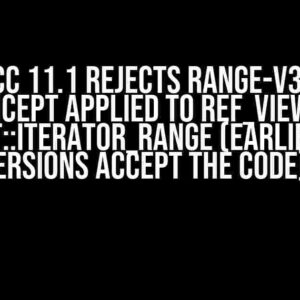As a React developer, you’ve probably stumbled upon a situation where React Signals refuse to render, leaving you wondering what’s going on. Meanwhile, UseState seems to work like a charm. In this article, we’ll dive into the world of React state management, exploring the differences between React Signals and UseState, and provide actionable tips to get your app rendering smoothly.
What are React Signals?
React Signals is a state management library developed by the Facebook team. It’s designed to provide a more efficient and scalable way of managing state in React applications. Signals are essentially a wrapper around the React context API, allowing you to create a global state that can be accessed anywhere in your app.
import { createSignal } from '@react-signal/core';
const [count, setCount] = createSignal(0);
function Counter() {
return (
Count: {count()}
);
}What is UseState?
UseState, on the other hand, is a built-in React Hook that allows you to add state to functional components. It’s a fundamental building block of React and is used extensively in modern React applications.
import { useState } from 'react';
function Counter() {
const [count, setCount] = useState(0);
return (
Count: {count}
);
}The Rendering Conundrum
Now, let’s get to the heart of the matter. Why does UseState render correctly, while React Signals seem to stubbornly refuse to render? To understand this, we need to delve into the inner workings of both libraries.
UseState: A Local State Solution
When you use UseState, React creates a local state that’s scoped to the component. This means that the state is tied to the component’s lifecycle and is re-rendered whenever the state changes.
| UseState | Description |
|---|---|
| Local State | Tied to the component’s lifecycle |
| Re-renders on state change | Automatic re-rendering |
React Signals: A Global State Solution
In contrast, React Signals create a global state that’s not tied to a specific component. This global state is stored in memory, allowing you to access it from anywhere in your app.
| React Signals | Description |
|---|---|
| Global State | Stored in memory, accessible globally |
| No automatic re-renders | Manual re-rendering required |
The Rendering Issue: A Closer Look
When you update a React Signal, it doesn’t automatically trigger a re-render. This is because the signal is stored in memory and not tied to a specific component. In contrast, UseState is tightly coupled with the component’s lifecycle, making it easier to trigger re-renders.
To illustrate this, let’s consider an example:
import { createSignal } from '@react-signal/core';
const [count, setCount] = createSignal(0);
function Counter() {
return (
Count: {count()}
);
}
function App() {
return (
In this example, when you click the “Increment” button, the `count` signal is updated, but the `Counter` component doesn’t re-render automatically. This is because the signal is stored in memory and not tied to the component’s lifecycle.
Solving the Rendering Issue
So, how do you get React Signals to render correctly? The answer lies in manually triggering re-renders whenever the signal changes.
Using useEffect
One way to achieve this is by using the `useEffect` hook to create a dependency on the signal. Whenever the signal changes, the effect will be re-run, triggering a re-render.
import { createSignal } from '@react-signal/core';
import { useEffect } from 'react';
const [count, setCount] = createSignal(0);
function Counter() {
useEffect(() => {
// Create a dependency on the signal
count();
}, [count]);
return (
Count: {count()}
);
}Using useSyncExternalStore
Another approach is to use the `useSyncExternalStore` hook, which is specifically designed for working with external stores like React Signals.
import { createSignal } from '@react-signal/core';
import { useSyncExternalStore } from 'use-sync-external-store';
const [count, setCount] = createSignal(0);
function Counter() {
const countValue = useSyncExternalStore(count, (snapshot) => snapshot());
return (
Count: {countValue}
);
}Best Practices for Using React Signals
To avoid rendering issues with React Signals, follow these best practices:
- Use signals sparingly: React Signals are best suited for global state that’s accessed infrequently. For local state, stick with UseState.
- Manual re-renders: Use `useEffect` or `useSyncExternalStore` to create dependencies on the signal and trigger re-renders manually.
- Avoid nested signals: Nested signals can lead to performance issues and make debugging more challenging. Instead, flatten your signal hierarchy.
- Optimize signal updates: Minimize updates to signals by batching changes or using debouncing techniques.
Conclusion
In conclusion, React Signals and UseState are two different beasts when it comes to state management in React. While UseState provides a local state solution with automatic re-renders, React Signals offer a global state solution that requires manual re-renders. By understanding the differences between these two libraries and following best practices, you can harness the power of React Signals to build fast, scalable, and efficient React applications.
Remember, when working with React Signals, it’s essential to manually trigger re-renders using `useEffect` or `useSyncExternalStore`. By doing so, you’ll ensure that your app renders correctly and efficiently, providing a seamless user experience.
So, go ahead and give React Signals a try in your next React project. With these tips and tricks, you’ll be well on your way to mastering this powerful state management library.
Here is the requested FAQ section:
Frequently Asked Question
Ever wondered why React Signals doesn’t render while useState does? Let’s dive into the world of React and uncover the mysteries!
Why does React Signals not render immediately like useState?
React Signals, by design, doesn’t trigger a re-render immediately after setting a new value. This is because Signals are meant to handle concurrent updates, allowing for more efficient rendering. On the other hand, useState triggers a re-render on every state change, which can lead to unnecessary re-renders.
Is React Signals a replacement for useState?
Not exactly! React Signals is designed to handle concurrent updates and provides a more efficient way of handling state changes. useState, on the other hand, is a fundamental hook for managing state in React. You can use both in tandem, depending on the specific needs of your application.
Can I use React Signals with existing useState code?
Absolutely! You can refactor existing code to use React Signals alongside useState. This allows you to take advantage of the benefits of both. However, be mindful of the differences in how they handle state changes and re-renders.
How does React Signals improve performance?
By batching multiple state updates together, React Signals reduces the number of unnecessary re-renders, resulting in improved performance. This is especially beneficial in scenarios where multiple state changes occur in rapid succession.
Are there any caveats to using React Signals?
One important thing to keep in mind is that React Signals requires a deeper understanding of how concurrent updates work in React. Additionally, it might require some refactoring of your existing code to take full advantage of its benefits.






